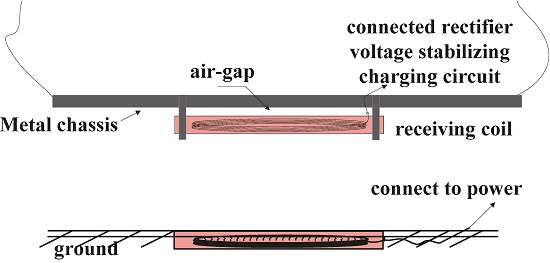Analysis and Performance Improvement of WPT Systems in the Environment of Single Non-Ferromagnetic Metal Plates
Abstract
:1. Introduction
2. The Influence of a Single-Side Metal Plate on Coil Parameters
2.1. Influence of a Single-Side Metal Plate on a Single-Turn Coil
2.2. Influence of a Single-Side Metal Plate on Multi-Turn Coil
3. Modeling and Experimental Research of WPT Systems with a Single-Side Metal Plate
3.1. Modeling and Parameter Idetification of Systems with a Single-Side Metal Plate
3.2. Simulation and Experimental Research of a Coil with a Single-Side Metal Plate
3.3. Simulation and Experimental Research of WPT System with a Single-Side Metal Plate
4. Performance Improvement of WPT System with a Single-Side Metal Plate
4.1. Application of Ferrite Cores and Its Effect on the Receiving Coil
4.2. Comparative Experiments on Performance of Systems with and without Ferrite Cores
5. Discussion
6. Conclusions
Acknowledgments
Author Contributions
Conflicts of Interest
References
- Shinohara, N. Power without wires. IEEE Microw. Mag. 2011, 12, S64–S73. [Google Scholar] [CrossRef]
- Kim, J.; Sun, C.; Suh, I. A proposal on wireless power transfer for medical implantable applications based on reviews. In Proceedings of the 2014 IEEE on Wireless Power Transfer Conference (WPTC), Jeju, Korea, 8–9 May 2014; pp. 166–169.
- Shin, J.; Shin, S.; Kim, Y.; Ahn, S.; Lee, S.; Jung, G.; Jeon, S.; Cho, D. Design and Implementation of Shaped Magnetic-Resonance-Based Wireless Power Transfer System for Roadway-Powered Moving Electric Vehicles. IEEE Trans. Ind. Electron. 2013, 61, 1179–1192. [Google Scholar] [CrossRef]
- Taylor, J.A.; Low, X.N.; Casanova, J.; Lin, J. A wireless power station for laptop computers. In Proceedings of the 2010 IEEE on Radio and Wireless Symposium (RWS), New Orleans, LA, USA, 10–14 January 2010; pp. 625–628.
- Kim, J.; Bien, F. Electric field coupling technique of wireless power transfer for electric vehicles. In Proceedings of the 2013 IEEE on TENCON Spring Conference, Sydney, Australia, 17–19 April 2013; pp. 267–271.
- Cho, I.; Kim, S.; Moon, J.; Yoon, J.; Jeon, S.; Choi, J. Wireless power transfer system for docent robot by using magnetic resonant coils. In Proceedings of the 2013 IEEE 5th International Symposium on Microwave, Antenna, Propagation and EMC Technologies for Wireless Communications (MAPE), Chengdu, China, 29–31 October 2013; pp. 251–254.
- Wang, Z.; Wei, X.; Dai, H. Design and Control of a 3 kW Wireless Power Transfer System for Electric Vehicles. Energies 2015, 9, 10. [Google Scholar] [CrossRef]
- Basar, M.R.; Ahmad, M.Y.; Cho, J.; Ibrahim, F. Application of wireless power transmission systems in wireless capsule endoscopy: An overview. Sensors 2014, 14, 10929–10951. [Google Scholar] [CrossRef] [PubMed]
- Kang, J.; Park, H.; Jang, J.; Lee, K. A design of wide input range, high efficiency rectifier for mobile wireless charging receiver. In Proceedings of the 2014 IEEE on Wireless Power Transfer Conference (WPTC), Jeju, Korea, 8–9 May 2014; pp. 154–157.
- Son, H.; Kim, J.; Park, Y.; Kim, K. Efficiency analysis and optimal design of a circular loop resonant coil for wireless power transfer. In Proceedings of the 2010 Asia-Pacific Microwave Conference, Yokohama, Japan, 7–10 December 2010; pp. 849–852.
- Chen, W.; Chinga, R.A.; Yoshida, S.; Lin, J.; Chen, C.; Lo, W. A 25.6 W 13.56 MHz wireless power transfer system with a 94% efficiency GaN Class-E power amplifier. In Proceedings of the 2012 IEEE MTT-S International Microwave Symposium Digest (MTT), Montreal, QC, Canada, 17–22 June 2012; pp. 1–3.
- Campi, T.; Cruciani, S.; Feliziani, M. Magnetic shielding of wireless power transfer systems. In Proceedings of the 2014 International Symposium on Electromagnetic Compatibility (EMC’14/Tokyo), Tokyo, Japan, 12–16 May 2014; pp. 422–425.
- Kim, J.; Kim, J.; Kong, S.; Kim, H.; Suh, I.; Suh, N.P.; Cho, D.; Kim, J.; Ahn, S.; Ahn, S. Coil Design and Shielding Methods for a Magnetic Resonant Wireless Power Transfer System. Proc. IEEE 2013, 101, 1332–1342. [Google Scholar] [CrossRef]
- Kudo, H.; Ogawa, K.; Oodachi, N.; Deguchi, N.; Shoki, H. Detection of a metal obstacle in wireless power transfer via magnetic resonance. In Proceedings of the 2011 IEEE 33rd International Telecommunications Energy Conference (INTELEC), Amsterdam, The Netherland, 9–13 October 2011; pp. 1–6.
- Ogawa, K.; Oodachi, N.; Obayashi, S.; Shoki, H. A study of efficiency improvement of wireless power transfer by impedance matching. In Proceedings of the 2012 IEEE MTT-S International Microwave Workshop Series on Innovative Wireless Power Transmission: Technologies, Systems, and Applications (IMWS), Kyoto, Japan, 10–11 May 2012; pp. 155–157.
- Kim, S.; Park, H.; Kim, J.; Kim, J.; Ahn, S. Design and Analysis of a Resonant Reactive Shield for a Wireless Power Electric Vehicle. IEEE Trans. Microw. Theory Tech. 2014, 62, 1057–1066. [Google Scholar] [CrossRef]
- Moon, H.; Kim, S.; Park, H.H.; Ahn, S. Design of a Resonant Reactive Shield with Double Coils and a Phase Shifter for Wireless Charging of Electric Vehicles. IEEE Trans. Magn. 2015, 51, 1–4. [Google Scholar] [CrossRef]
- Kaneda, J.; Miwa, K.; Kikuma, N.; Hirayama, H.; Sakakibara, K. Relation analysis between feeding structures and effect of shield for coils in wireless power transfer with magnetically coupled resonance. In Proceedings of the 2012 International Symposium on Antennas and Propagation (ISAP), Nagoys, Japan, 29 October–2 November 2012; pp. 1208–1211.
- Kitano, Y.; Omori, H.; Morizane, T.; Kimura, N.; Nakaoka, M. A new shielding method for magnetic fields of a wireless EV charger with regard to human exposure by eddy current and magnetic path. In Proceedings of the 2014 International Power Electronics and Application Conference and Exposition, Shanghai, China, 5–8 November 2014; pp. 778–781.
- Feliziani, M.; Cruciani, S. Mitigation of the magnetic field generated by a wireless power transfer (WPT) system without reducing the WPT efficiency. In Proceedings of the 2013 International Symposium on Electromagnetic Compatibility (EMC EUROPE), Brugge, Belgium, 2–6 September 2013; pp. 610–615.
- Lawson, J.; Yates, D.C.; Mitcheson, P.D. Efficient artificial magnetic conductor shield for wireless power. In Proceedings of the 2015 IEEE on Wireless Power Transfer Conference (WPTC), Boulder, CO, USA, 13–15 May 2015; pp. 1–4.
- Selection of Single-Wire Nominal Diameter. Available online: http://www.elektrisola.com/en/hf-litz-wire/terminology-basics/selection-of-litz-wire-parameters.html (accessed on 3 May 2016).
- Tan, L.L.; Huang, X.L.; Huang, H.; Zou, Y.W.; Li, H. Transfer efficiency optimal control of magnetic resonance coupled system of wireless power transfer based on frequency control. Sci. China Technol. Sci. 2011, 54, 1428–1434. [Google Scholar] [CrossRef]
- Pantic, Z.; Lukic, S. Computationally-Efficient, Generalized Expressions for the Proximity-Effect in Multi-Layer, Multi-Turn Tubular Coils for Wireless Power Transfer Systems. IEEE Trans. Magn. 2013, 49, 5404–5416. [Google Scholar] [CrossRef]
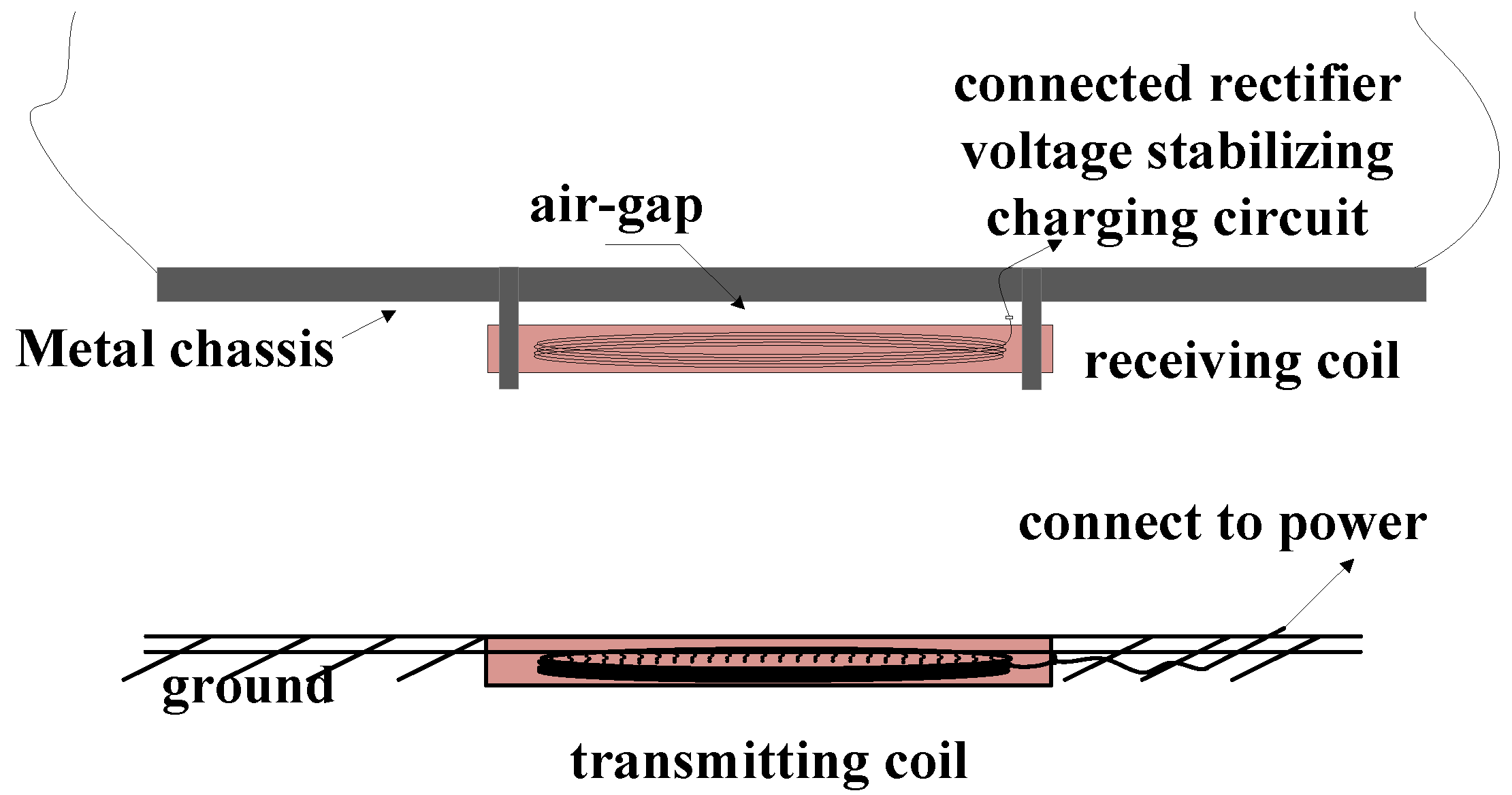


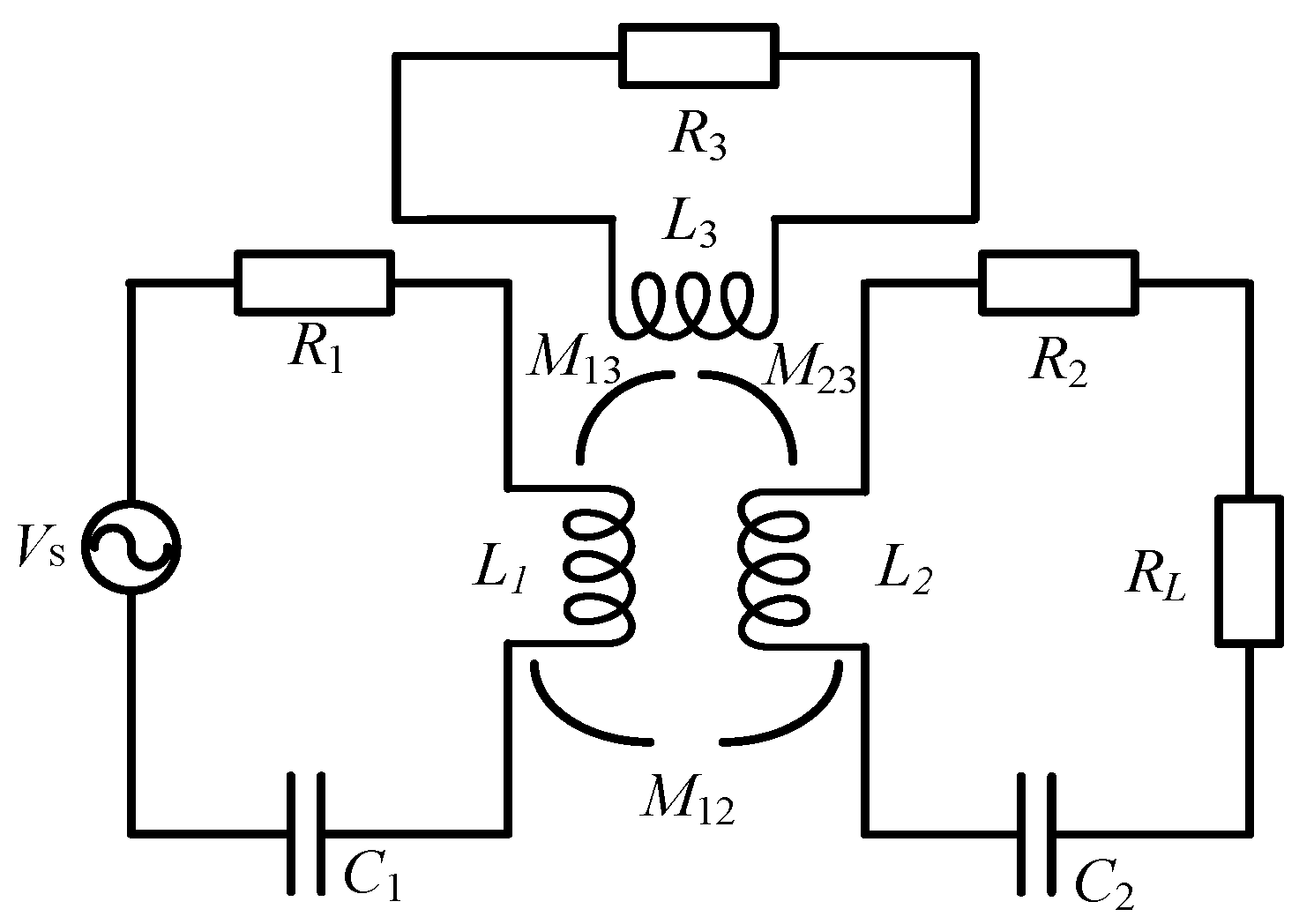




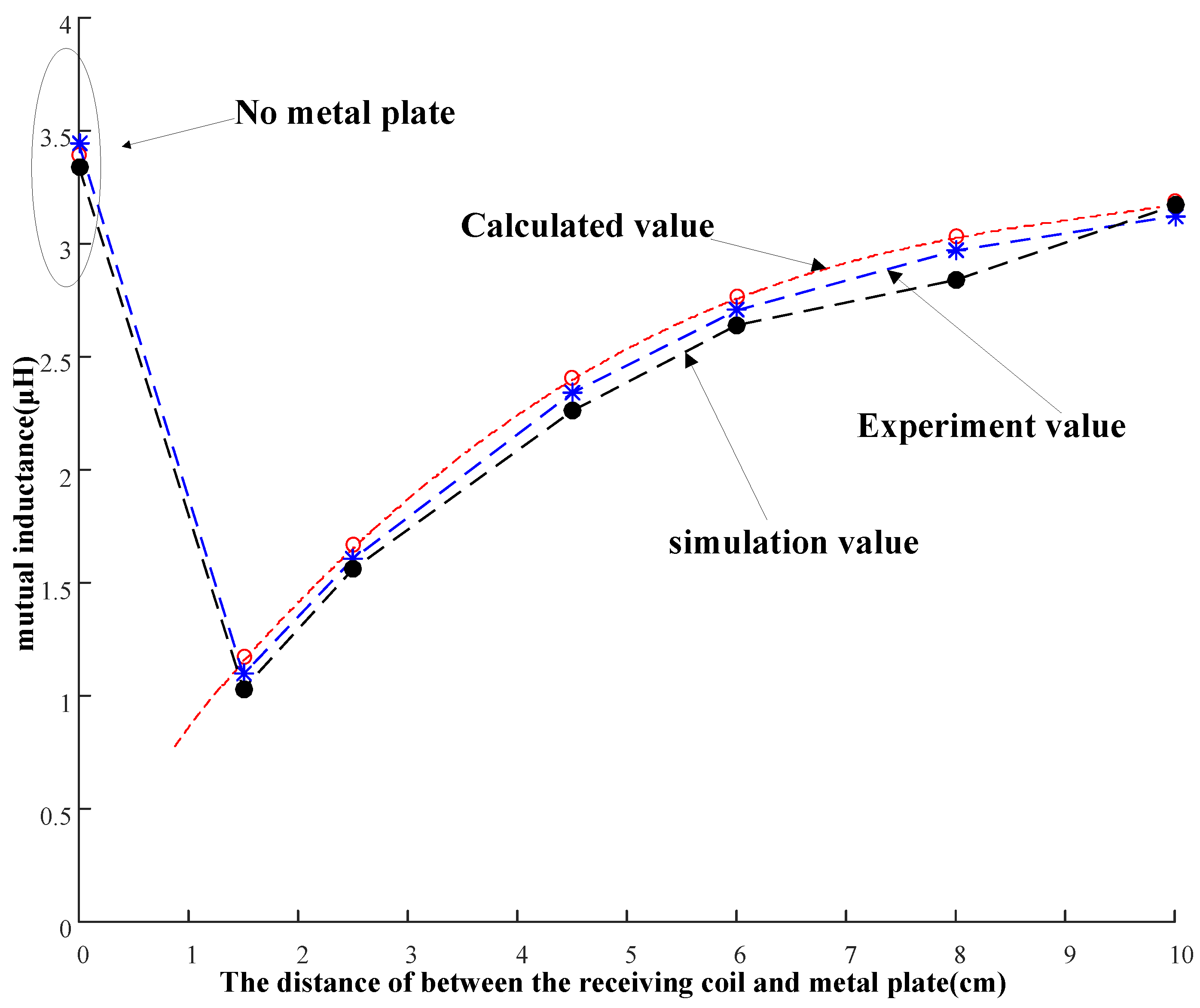


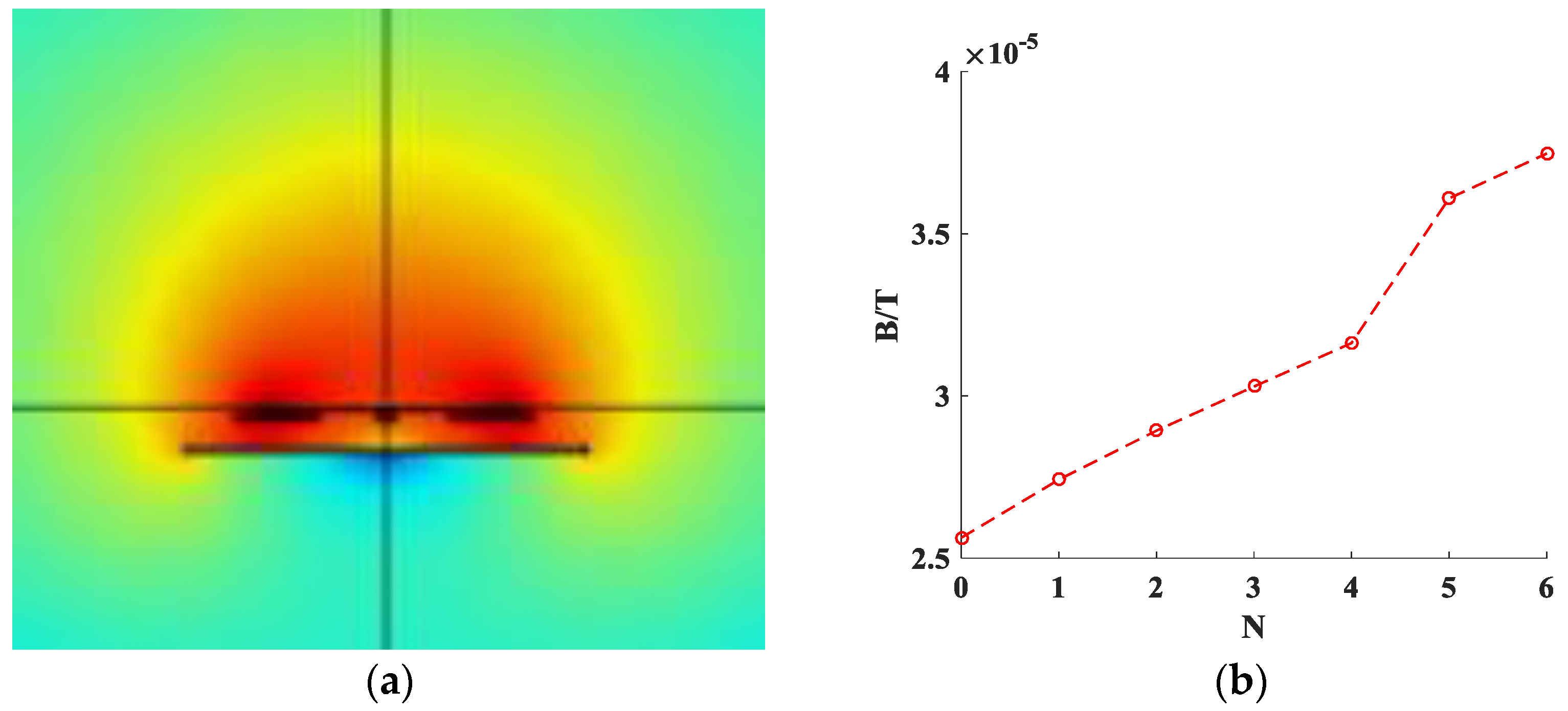




| Parameter | Value |
|---|---|
| External radius | 20 cm |
| Inner radius | 16 cm |
| Coil turns N | 10 |
| Wire diameter | 2 mm |
| Frequency f | 73 kHz |
| Inner resistance R | 0.05 Ω |
| Ferrite Cores | Coil Inductance (μH) | Resonant Frequency (kHz) | ||
|---|---|---|---|---|
| Simulation Values | Measured Values | Simulation Values | Measured Values | |
| None | 23.401 | 23.42 | 94.98 | 94.75 |
| ① | 28.48 | 28.56 | 86.09 | 85.97 |
| ①② | 30.57 | 30.59 | 83.08 | 83.01 |
| ①②③④ | 34.25 | 34.17 | 78.51 | 78.39 |
| ①②③④⑤ | 35.76 | 35.20 | 76.83 | 76.82 |
| ①②③④⑤⑥ | 39.65 | 40.04 | 72.96 | 72.95 |
© 2016 by the authors; licensee MDPI, Basel, Switzerland. This article is an open access article distributed under the terms and conditions of the Creative Commons Attribution (CC-BY) license (http://creativecommons.org/licenses/by/4.0/).
Share and Cite
Tan, L.; Li, J.; Chen, C.; Yan, C.; Guo, J.; Huang, X. Analysis and Performance Improvement of WPT Systems in the Environment of Single Non-Ferromagnetic Metal Plates. Energies 2016, 9, 576. https://doi.org/10.3390/en9080576
Tan L, Li J, Chen C, Yan C, Guo J, Huang X. Analysis and Performance Improvement of WPT Systems in the Environment of Single Non-Ferromagnetic Metal Plates. Energies. 2016; 9(8):576. https://doi.org/10.3390/en9080576
Chicago/Turabian StyleTan, Linlin, Jiacheng Li, Chen Chen, Changxin Yan, Jinpeng Guo, and Xueliang Huang. 2016. "Analysis and Performance Improvement of WPT Systems in the Environment of Single Non-Ferromagnetic Metal Plates" Energies 9, no. 8: 576. https://doi.org/10.3390/en9080576




